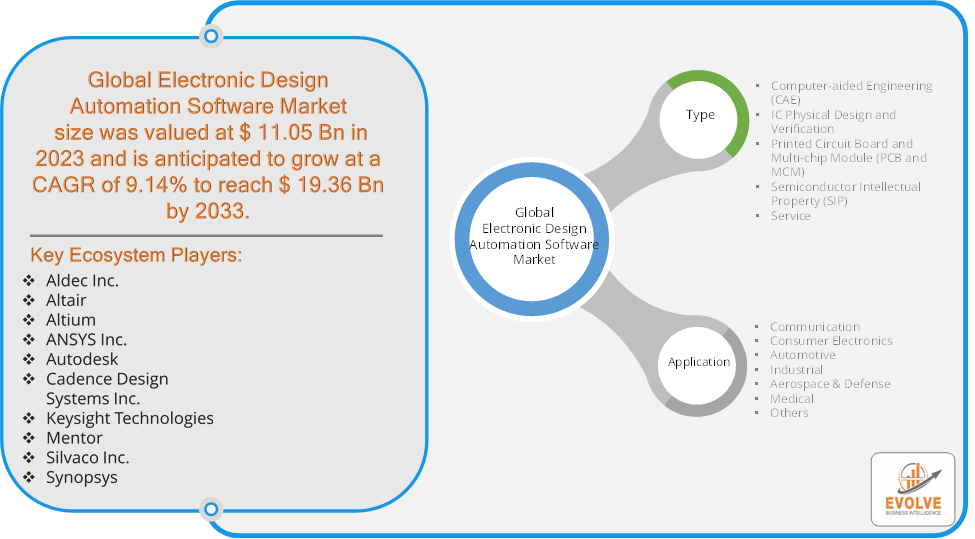Electronic Design Automation Market Grows: 9.14% CAGR

Evolve Business Intelligence has published a research report on the Global Electronic Design Automation Software Market, 2023–2033. The global Electronic Design Automation Software Market is projected to exhibit a CAGR of around 9.14% during the forecast period of 2023 to 2033.
Evolve Business Intelligence has recognized the following companies as the key players in the global Electronic Design Automation Software Market: Aldec Inc., Altair, Altium, ANSYS Inc., Autodesk, Cadence Design Systems Inc., Keysight Technologies, Mentor, Silvaco Inc. and Synopsys.
 More Information: https://evolvebi.com/report/debt-collection-software-market-analysis/
More Information: https://evolvebi.com/report/debt-collection-software-market-analysis/
Market Highlights
The Global Electronic Design Automation Software Market is projected to be valued at USD 19.36 Billion by 2033, recording a CAGR of around 9.14% during the forecast period. The Electronic Design Automation (EDA) Software Market refers to the industry surrounding the development, distribution, and use of software tools that assist engineers in the design, analysis, and verification of electronic systems and components. EDA software is essential for designing complex electronics, such as integrated circuits (ICs), printed circuit boards (PCBs), and systems on chips (SoCs).
The EDA Software Market is crucial for enabling innovation and development in the electronics industry, supporting the creation of increasingly sophisticated electronic devices.
The COVID-19 pandemic had significant impacts on the Electronic Design Automation (EDA) Software Market. The pandemic led to a surge in demand for electronics, driven by remote work, online education, and increased consumer spending on home entertainment. This, in turn, boosted the need for EDA tools to design and develop new electronic products. The shift towards digital platforms and the need for advanced technological solutions accelerated the adoption of EDA software. Companies invested in digital tools to maintain continuity in product development during lockdowns. The pandemic underscored the importance of remote collaboration, leading to increased adoption of cloud-based EDA tools. These tools allowed design teams to work together from different locations, ensuring project continuity. The pandemic disrupted global supply chains, affecting the production of semiconductors and other electronic components. This had a ripple effect on the EDA market, as delays in component availability slowed down design and development timelines.
Segmental Analysis
The global Electronic Design Automation Software Market has been segmented based on Type and Application.
Based on Type, the Electronic Design Automation Software Market is segmented into Computer-aided Engineering (CAE), IC Physical Design and Verification, Printed Circuit Board and Multi-chip Module (PCB and MCM), Semiconductor Intellectual Property (SIP) and Service. The Semiconductor Intellectual Property (SIP) segment is anticipated to dominate the market.
Based on Application, the global Electronic Design Automation Software Market has been divided into Communication, Consumer Electronics, Automotive, Industrial, Aerospace & Defense, Medical and Others. The Consumer Electronics segment is anticipated to dominate the market.
More Information: https://evolvebi.com/report/debt-collection-software-market-analysis/
Regional Analysis
The Electronic Design Automation Software Market is divided into five regions: North America, Europe, Asia-Pacific, South America, and the Middle East, & Africa. North America, particularly the United States, is a dominant player in the EDA Software Market. The region is home to some of the largest semiconductor companies, technology firms, and EDA tool providers, such as Cadence Design Systems, Synopsys, and Mentor Graphics (a Siemens company). The U.S. is a global leader in technology innovation, with significant investments in R&D. The presence of top-tier universities and research institutions also contributes to the development and adoption of advanced EDA tools. Europe has a well-established EDA Software Market, with a strong focus on industries such as automotive, aerospace, and industrial electronics. Germany, France, and the UK are key contributors to the market. Europe is a global leader in automotive innovation, with a strong emphasis on electric vehicles (EVs) and advanced driver-assistance systems (ADAS). The demand for EDA tools to design and verify automotive electronics is high, driving market growth in the region. Asia-Pacific is one of the fastest-growing regions in the EDA Software Market, driven by the booming electronics manufacturing sector, particularly in countries like China, Japan, South Korea, and Taiwan. Countries like China and India are increasingly investing in R&D, supported by government initiatives to boost domestic semiconductor capabilities. This is creating new opportunities for EDA software providers in the region. The EDA Software Market in the Middle East and Africa is in a nascent stage, with growth driven by increasing industrialization and investment in technology infrastructure. Countries like the UAE, Saudi Arabia, and South Africa are investing in infrastructure development, including smart cities and telecommunications, which creates demand for EDA tools in designing and deploying electronic systems. Latin America is gradually emerging as a market for EDA software, driven by increasing technological adoption and investment in electronics manufacturing. Brazil and Mexico are the largest contributors in the region, with growing industries in consumer electronics, automotive, and telecommunications. These countries are seeing increased demand for EDA tools as they enhance their manufacturing and R&D capabilities.


